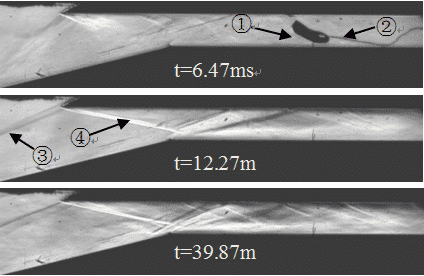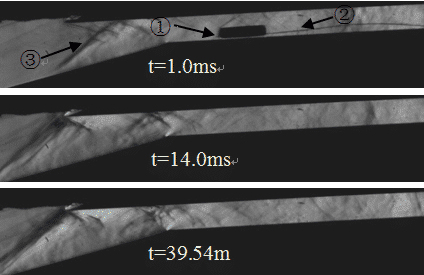A hypersonic inlet plays an important role in capturing and compressing air for an air breathing engine that operates at supersonic and/or hypersonic speeds, of which the starting characteristics must be clarified in order to ensure the performance and safe flight of the vehicle (Van Wie et al. 1996). In the present work, we focus on the effects of attack angles on the inlet starting behaviors under a given incoming flow Mach number. Both starting and self-starting characteristics are the main interests of this study.
The experiments were conducted in a shock tunnel at our university, whose test time can be last for about 40 ms with a free stream flow Mach number of M∞=5.9, total pressure of Po=1.27MPa and total temperature of To=810K. A two dimensional simplified inlet model with an internal contraction ratio of 1.77 was designed for the tests (see Fig. 1). Since a shock tunnel has a strong help-to-start effect during the establishment of the operation as long as the initial pressure of the vacuum tank is sufficiently low, an examination of the inlet starting capability could be performed directly. On the other hand, a light moveable obstacle that serves as a temporal flow plug was placed in the downstream of the isolation channel in order to check the self-starting capability of the inlet (Li et. al. 2012). Simultaneous high speed schlieren visualization and surface pressure measurements were applied to characterize the inlet flow.
Currently the angles of attack (AOA) have been tested were ranged from -4° to +4°. The starting capabilities of the inlet model were well verified for all of the tested AOAs and there is no need to be shown here. On the other hand, the self-starting behaviors were found to be different for various angles of attack and a pitching down motion exhibits a favorable trend to the self-starting performance whereas a pitching up is the opposite. Figure 2a shows a series of schlieren photos taken at angel of attack of 0o, in which a supersonic flow is restarted soon after the plug is blown away and illustrates clearly a self-started inlet flow. For the AOA of 4° however, an un-started flow constantly remains during the whole operation time after the plug is removed (see Fig. 2b), therefore it can be reasonably concluded that the flow is not self-started. A numerical simulation was also carried out for the same inlet model. The numerical results showed that the critical values of starting and self-starting attack angles were in the range of 12o- 14o and 0o-2o respectively, which roughly agree with the experimental observations. A simple explanation of the effects of attack angle is that, for an increased angle of attack, the effective incoming flow Mach number decreases before the entrance of a 2D inlet, therefore the starting/self-starting capability declines accordingly. More results and discussions are planned to be completed in the coming full length paper.

Figure 1. Schematic of the inlet model (in:mm)


①Mark;②Thread;③Ramp shock; ④Cowl shock ①Mark;②Thread;③Separation shock
(a)AOA=0° (b)AOA=4°
Figure 2. Schlieren images of inlet for free stream of M∞=5.9

